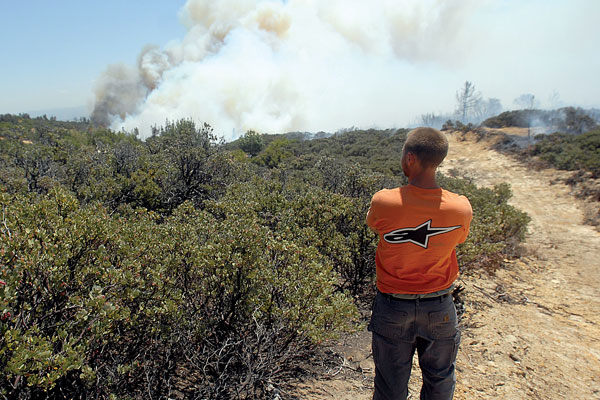
Cars loaded to the brim and hitched to boats and trailers snaked
down Summit Road after about 1,400 homes were evacuated Thursday
morning. Few residents living off the dirt road high up in the
mountains waited around to watch their homes burn in the
wildfire.
Cars loaded to the brim and hitched to boats and trailers snaked down Summit Road after about 1,400 homes were evacuated Thursday morning. Few residents living off the dirt road high up in the mountains waited around to watch their homes burn in the wildfire.
Fire engines lined Summit Road about 10 miles away from the Mount Madonna County Park rangers station and more rumbled in to offer relief. Firefighters scurried around doing what they could to fight the blaze – dubbed the Summit Fire – that engulfed the mountain about 15 miles northwest of Gilroy.
“The elements are not kind up here,” said Mark Hamlin, one of the few residents of Summit Road who stuck around. He stood bundled up atop one of the mountain peaks, watching firefighters hack at the scrub around his modest home.
Firefighters worked quickly with the help of shovels, chainsaws and axes to clear the land immediately surrounding structures and lining roads. They had to shout over the whistling wind and crackling flames to be heard. The exhausted firefighters will be on duty for 24 hour shifts for about a week, Capt. Bill Morrison of the Saratoga Fire Department predicted.
“Our objective is to keep it on that side of Summit,” Morrison said, gesturing to the western side of Summit Road where the flames licked at brush alarmingly close to the road. Winds reaching nearly 50 miles per hour drove flames that jumped from clump to clump of vegetation scorched dry by the sun.
“The dry spell over the last few weeks combined with the wind this week are not helping us,” said Firefighter Paul Lellman as his crew monitored the fire from the mountaintop. Planes buzzed overhead, intermittently spewing trails of bright red fire retardant mixed with fertilizer to promote growth and prevent erosion after the fire is extinguished.
The concoction coated Hamlin’s home, car and yard. He waited anxiously as the fire approached his home of 15 years.
“This isn’t surprising,” he said. “It was bound to happen and it finally did. It’s just so awful dry out here,” he said kicking at the dusty ground underfoot.
“I live light,” he said. With no fire insurance, he has to. He pulled his sweatshirt more tightly around him, braving the howling winds and billowing smoke.
Between the dust and smoke whipping over the ridges of Mount Madonna, visibility was slim to none, making it that much harder to target hot spots. The rocky terrain just added to the challenge, Morrison said.
Down the road, Billy Russell watched as plumes of smoke wrapped around his property. Just last week, Russell put the finishing touches on his new home. A resident of Santa Cruz, he was planning to move into his new home in a couple weeks with his wife who is due to give birth to their first child in four months. The young family may have to rebuild their home if the fire spreads to the structure. Before the fire, the home had been surrounded by beautiful trees, he said.
“This is not good,” he said, starring at the wall of thick, gray smoke. Within minutes, his home was hidden. A Pacific Gas and Electric employee, he spent the previous night cutting down and repairing power lines downed by the wind.
“I worked all night and woke up to this,” he said. “I woke up to phone calls telling me the mountains are on fire.”
Despite his sleepless night, he drove to his new house where he started clearing the land.
“I haven’t even moved in yet,” he said. “I’m moving up here soon. “Well, this is changing things. This is not good,” he repeated, shaking his head.
Planes dropped several loads of fire retardant in the general vicinity of his home but the residents radiated one emotion: anxiety.
“This has been the longest morning,” Hamlin said. “How’s my house doing?” he asked. Firefighters couldn’t give him a definite answer. Even if his home was saved, it was coated under layers of bright red retardant.
The pilots had to use caution when spraying the flames, Morrison pointed out. After three drops, they had to refuel and restock their supplies on the ground.
“They have to be right on when they do their drops,” he said. On the ground, his crew was also careful to conserve their supplies. Many of the small fires that leapt up burned themselves out.
“We’ll do everything we can do without using water,” a member of his crew said. With only 500 gallons of water in their tank, spraying smaller brush fires were delayed. The firefighters conducted a project triage, flocking to endangered structures like Hamlin’s and Russell’s over brush fires.
“I want that smoke to clear,” Russell said. “But I don’t know what I’m going to see when it does.”








